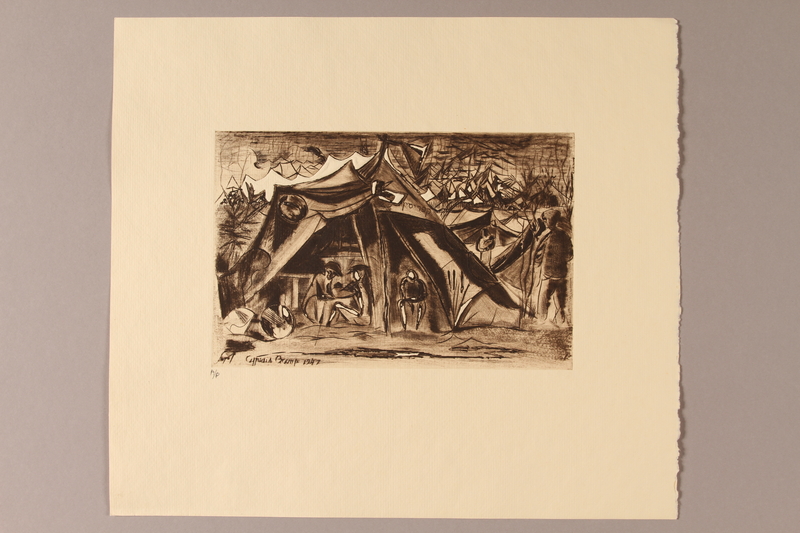Overview
- Brief Narrative
- Artist's proof of an etching based on a drawing created by Albert Dov Sigal in 1948 while he was imprisoned with his wife, Rozi, and young son, Daniel, in a British detention camp in Cyprus waiting for permission to enter Palestine. based upon the experiences of his family as newly arrived emigrants to Palestine on February 22, 1948. It depicts the artist and his family as they arrive in their new home. It is an image The print shows a group of people seated inside a tent. Palestine was ruled by the British under a United Nations mandate and the postwar immigration policy was very restrictive. Ships attempting to bring unauthorized refugees to the country were stopped and the passengers were interned. In 1939, Sigal was arrested by the fascist, antisemitic Romanian government and assigned to a forced labor battalion that repaired and built roads and railways. He started an underground art school with a group of friends and was active in the Romanian resistance. On December 27, 1947, the family sailed from Burgas, Bulgaria, towards Palestine aboard the Aliyah Bet illegal immigrant ship, Pan York. They were imprisoned by the British on Cyprus on December 31, 1947. Because his son was only 18 months old, Sigal and his family were permitted to enter Palestine on February 22, 1948. On May 14, the state of Israel was established and, within six months, all the refugees on Cyprus were welcomed into the Jewish homeland.
- Artwork Title
- Cyprus Detention Camp - Tents
- Date
-
creation:
1948
depiction: 1947 December
- Geography
-
depiction:
British detention camp;
Cyprus
creation: Israel
- Credit Line
- United States Holocaust Memorial Museum Collection, Gift of Rose Sigal Ibsen, In memory of my sisters, Olga Goichman and Lidia Rosenberg, and my husband, Albert Dov Sigal
- Contributor
-
Artist:
Albert Dov Sigal
Subject: Albert Dov Sigal
Subject: Rose Sigal-Ibsen
- Biography
-
Albert Dov Sigal was born in 1912 in Cluj-Napoca (Koloszvar), in the Transylvania region, when it was part of Hungary and the Austro-Hungarian Empire. In the aftermath of World War I (1914-1918), it was conquered by Romania. His parents were Helen and Moses Sigal and he had a sister, Eda. His father died when he was three years old and though his mother worked hard to provide for the family, life was difficult and food was scarce. His family was not religious, though he attended synagogue. But from a young age, he was fascinated by the more joyful, communal life of the devout Hasidim. He joined the Maccabi Hatzair, a Zionist youth and sports organization. He graduated from the Academy of Fine Arts, specializing in painting, enameling, and copper engraving.
In 1933, he moved to Bucharest. Albert exhibited widely and his work was acquired by the National Museum in Bucharest. But by 1939, he could not get work. He was arrested and made part of a forced labor battalion that repaired and built roads and railways. He had a near-fatal construction accident and then bribed Romanian authorities to keep him from heavy forced labor, until a non-Jewish Romanian artist friend got him a position in a local museum, Pinacoteca Statului. He joined with a group of artists, led by Maxi, to begin an underground art school. Romania had a long tradition of vicious antisemitism which was emboldened by the rise of Nazi Germany. Following years of near civil war, General Antonescu and the fascist Iron Guard seized power in late 1940. Jewish businesses were confiscated, property destroyed, and physical attacks and the murder of Jews became commonplace. In January 1941, there were pogroms throughout the country; the one in Bucharest had events of great savagery, such as the assembly and murder of dozens of Jews, including Albert’s uncle-in-law, in the slaughterhouse.
In mid-1941, he married Rozi Cohn, who was active in the Zionist movement, Hanoar Hatzioni. She was born on August 22, 1922, in Bucharest to Joseph and Tili Cohn. She became a partner with Albert in his work, assisting in his workshop and at the art school. They opened a small jewelry business under a Gentile name. The couple rented a small attic apartment, but they had to move in with Rozi’s family when she became ill after an appendectomy in August 1941. Albert, Rozi, and her family were scheduled to be transported to concentration camps on multiple occasions, but many wealthy Jews in the area bribed the Romanian authorities to postpone the dates. The Allied bombings of Bucharest began on April 4, 1944. Most of Romania was liberated by the Soviet Army that spring and, after the overthrow of General Antonescu, an armistice was signed with the Soviets on August 23, 1944. They learned that Rozi’s family members in Moldavia had been deported to concentration camps in Transnistria, where they presumably perished. The majority of Albert’s family members in Transylvania also did not survive the Holocaust.
Albert reestablished his artistic career in postwar Bucharest. In 1946, his work was shown at the National Museum which also purchased his artwork and gave him an award. He and Rozi had a son, Daniel Moses, on June 26, 1946. But they decided that they could no longer live in Romania. That year, they received the affidavit of support required for United States immigration visas from Albert’s family there, but they feared being arrested by Soviet or Romanian authorities and destroyed the papers. Instead, they appealed to a distant relation of Rozi’s who worked with Romanian authorities to arrange emigration to Palestine for Jewish refugees. They received priority treatment because of Rozi’s Zionist connections. However, they had to bribe the Romanian authorities with jewelry to get added to the exit permit list. In addition to Rozi, Albert, and Daniel, his mother, her parents, her uncle, and her sister’s family and mother-in-law also wished to leave the country. They all left Romania and on December 27, 1947, sailed for Palestine from Burgas, Bulgaria, aboard the Aliyah Bet illegal immigrant ship, Pan York. The ship was stopped by the British authorities who controlled Palestine and the nearly 8000 passengers were imprisoned in detention camps in Cyprus on December 31, 1947. While in the camps Albert continued to create drawings, often of the daily life in the camps. He also began making brooches from Cypriot coins which he sold to supplement the family’s food rations. In early 1948, the British began preparations for withdrawal. They decided that refugees with children two years old or younger would be allowed into Palestine. After four weeks in the camp, Rozi’s sister, brother-in-law, and their child left for Palestine; Rozi, Albert, and their 18 month old son, Daniel, left two weeks later, on February 22. The remaining family members soon followed.
On May 14, 1948, the state of Israel was established. Albert was one of the first artists to establish himself in the new state. He achieved international acclaim as an expert in the art of enameling and renewed interest in this ancient craft of applying finely crushed glass to metal, heating it until it fuses with the metal, then painting it with special paints. He was noted for his mastery of copper engraving and woodcut from which he produced etchings and lithographs, as well for his painting, metalwork, and drawings in many media. Sigal specialized in Hebraic and Biblical enamel paintings and his work was deeply expressive of his religious faith as well as his faith in the history and future of Israel. In December 1957, the American Jewish Congress held his first one man show in the United States. Rozi came to view the exhibit and persuaded Albert to move to New York in 1959. He and Rozi became naturalized citizens in 1965. Their son, David, also became celebrated for his skill in the art of enameling. Albert died of leukemia, age 58, on May 30, 1970.
Rozi (Rose) Cohn was born on August 22, 1922, in Bucharest, Romania, to Joseph and Cecilia Cohn. She had three younger sisters: Berta, Yehudit, and Lidia. Rozi’s mother was a dressmaker. The family was not observant, but they celebrated all the Jewish holidays. Rozi’s family was poor, but many of her aunts were affluent. When she was six and a half, she went to live with her maternal aunt and uncle, Esther and Isaac, who owned a bookstore. After her uncle died in 1936, Rozi returned to her parent’s home. Her aunt also moved in and the household now numbered ten, as her grandmother, a cousin, and two servants also lived there. They lived in a gentile neighborhood and experienced some antisemitism. Rozi joined the Zionist movement and studied for two years to be a dressmaker. In 1939, she started working as a cashier in a store owned by a German company in Bucharest.
In September 1940, Romania came under the rule of a fascist military coalition led by General Antonescu and the Iron Guard, which enacted restrictive and violent anti-Jewish measures. In January 1941, Rozi and her family had to hide in their apartment for three days due to a vicious government assisted pogrom. Two of Rozi’s uncles were taken from the synagogue and along with dozens of other Jewish citizens, murdered by the Iron guard in the Bucharest slaughterhouse. Rozi was dismissed from her cashier job for being Jewish. In mid-1941, she married Albert Dov Sigal, born in 1912, in Cluj-Napoca. Albert was an artist and a master engraver, but he had been conscripted as forced labor to do road and railway repairs. The couple rented a small attic apartment, but they had to move in with Rozi’s family when she became ill after an appendectomy in August 1941. The local doctor refused to come to the home because the family was Jewish. Her German Christian brother-in-law was acquainted with a German soldier who brought medication for her from Italy.
Rozi and her family stayed hidden in their apartment in Bucharest, though Rozi was able to walk around without raising suspicion because she did not look Jewish. Albert bribed Romanian authorities to keep him from heavy forced labor and, with the assistance of a non-Jewish artist friend, received papers to work in a museum. He was active in the Romanian resistance and led an underground art school with about 20 other artists where Rozi often modeled. Albert, Rozi, and her family were scheduled to be transported to concentration camps on multiple occasions, but many wealthy Jews in the area bribed the Romanian authorities to postpone the dates. The Allied bombings of Bucharest began on April 4, 1944. Most of Romania was liberated by the Soviet Army that spring and after the overthrow of General Antonescu, an armistice was signed with the Soviets on August 23, 1944. The family discovered that the Cohn family members in Moldavia had been deported to concentration camps in Transnistria, where they presumably perished. The majority of Albert’s family members in Transylvania also did not survive the Holocaust.
Postwar Romania was chaotic and almost erupted into civil war. But by the end of 1945, an authoritarian Communist regime, backed by Stalin, was established. Rozi and Albert had a son, Daniel Moses, on June 26, 1946, in Bucharest. The family continued to be affected by the deeply entrenched anti-Semitism in Romania, and they decided that they must leave the country. In 1946, Rozi and Albert received the affidavit of support required for United States immigration visas from Albert’s family there, but they feared being arrested by Soviet or Romanian authorities and destroyed the papers. Instead, they appealed to a distant relation of Rozi’s who worked with Romanian authorities to arrange emigration to Palestine for Jewish refugees. Rozi and her family received priority treatment because of her involvement with Zionism, but they had to bribe Romanian authorities with jewelry to get added to the exit permit list. In addition to Rozi, Albert, and Daniel, her parents, her mother-in-law, her uncle, and her sister’s family and mother-in-law also wished to leave the country. They all left Romania and on December 27, 1947, sailed for Palestine from the port of Burgas in Bulgaria aboard the Aliyah Bet illegal immigrant ship, Pan York. The ship was stopped by the British authorities who controlled Palestine and the nearly 8000 passengers were imprisoned in detention camps in Cyprus on December 31, 1947. In early 1948, the British began preparations for withdrawal. They decided that refugees with children two years old or younger would be allowed into Palestine. After four weeks in the camp, Rozi’s sister, brother-in-law, and their child left for Palestine; Rozi, Albert, and their son, Daniel, left two weeks later, on February 22. The remaining family members soon followed. On May 14, 1948, the state of Israel was established.
In December 1957, the American Jewish Congress held Albert's first one man show in the United States. Rozi came to view the exhibit and persuaded Albert to move to New York in 1959. Rozi and Albert became naturalized citizens in 1965. Albert achieved international fame for his mastery of enamels. Their son, Daniel, also became celebrated for his skill in the art of enameling. Albert died on May 30, 1970, age 58. Rozi remarried Joseph Ibsen (1914-1991) in 1973. She is a frequently exhibited artist who specializes in Sumi-e brush painting and calligraphy.
Physical Details
- Language
- English
- Classification
-
Art
- Category
-
Prints
- Object Type
-
Etching (lcsh)
- Physical Description
- Monochrome sepia etching on square, light brown paper. In the foreground is a triangular tent divided into 2 compartments by a central support pole and partition. The open front flaps shows 3 men within: 2 on the right wear caps and sit on the ground, facing each other over a low table; on the left is a lone man sitting on a chair, elbows on his knees. On the right tent exterior is Hebrew text and a number. The central pole extends through the top, bends right, and ends in a triangular shape. At the right edge stands a man wearing a hat, seen from the back. To the right behind the tent is a faceless woman in headscarf and robe, holding a baby. There is an open tent directly behind her and, spanning the background are many pointed tent tops and a wall of thin, vertical lines, reminiscent of a barbed wire fence. Bright white gouache is thickly applied to the figures, tents, and landscape, contrasting with dark cross hatched areas. Letters are inscribed on the front. Etched on the plate are the artist’s signature, Sigal, and Cyprus Camp 1947. On the back is a number inscribed in ink and a purple stamp.
- Dimensions
- overall: Height: 11.500 inches (29.21 cm) | Width: 13.000 inches (33.02 cm)
pictorial area: Height: 5.500 inches (13.97 cm) | Width: 8.250 inches (20.955 cm) - Materials
- overall : paper, ink, gouache, graphite
- Inscription
- front, left, pencil : A/P
back, upper right, handwritten, blue ink : #4
back, lower right, stamped in semi-circle, purple ink : FROM THE ESTATE OF / ALBERT D. SIGAL
Rights & Restrictions
- Conditions on Access
- No restrictions on access
- Conditions on Use
- No restrictions on use
Keywords & Subjects
Administrative Notes
- Legal Status
- Permanent Collection
- Provenance
- The etching was donated to the United States Holocaust Memorial Museum in 1990 by Rose Sigal Ibsen, the widow of Albert Dov Sigal.
- Funding Note
- The cataloging of this artifact has been supported by a grant from the Conference on Jewish Material Claims Against Germany.
- Record last modified:
- 2022-07-28 18:21:22
- This page:
- https://collections.ushmm.org/search/catalog/irn3284
Download & Licensing
In-Person Research
- By Appointment
- Request 21 Days in Advance of Visit
- Plan a Research Visit
- Request to See This Object
Contact Us
Also in Albert Dov Sigal collection
The collection consists of artwork created by Albert Dov Sigal relating to his experiences in a British detention camp in Cyprus in 1948 where he and his family were held after the ship on which they sailed from Romania to Palestine was captured by the British Navy.
Date: 1948
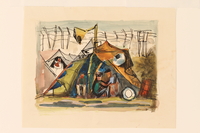
Albert Dov Sigal watercolor painting of men seated in a tent in a detention camp created during his imprisonment
Object
Watercolor by Albert Dov Sigal made in 1948 while he was imprisoned with his wife, Rozi, and son, Daniel, in a British detention camp in Cyprus waiting for permission to enter Palestine. The painting shows a group of men sitting inside a tent with the wire fence of the detention camp in the background. Palestine was ruled by the British under a United Nations mandate and the postwar immigration policy was very restrictive. Ships attempting to bring unauthorized refugees to the country were stopped and the passengers were interned. In 1939, Sigal was arrested by the fascist, antisemitic Romanian government and assigned to a forced labor battalion that repaired and built roads and railways. He started an underground art school with a group of friends and was active in the Romanian resistance. On December 27, 1947, the family sailed from Burgas, Bulgaria, towards Palestine aboard the Aliyah Bet illegal immigrant ship, Pan York. They were imprisoned by the British on Cyprus on December 31, 1947. Because his son was only 18 months old, Sigal and his family were permitted to enter Palestine on February 22, 1948. On May 14, the state of Israel was established and, within six months, all the refugees on Cyprus were welcomed into the Jewish homeland.
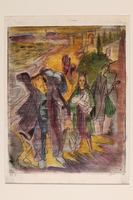
Albert Dov Sigal multicolored lithograph of a young woman, holding an infant, with her family on a golden road, based upon his experience as a refugee
Object
Artist's proof print for a lithograph based on a drawing created by Albert Dov Sigal based upon the experiences of his family as newly arrived emigrants to Palestine on February 22, 1948. It depicts the artist and his family as they arrive in their new home. It is an image of a man carrying bags being followed by two woman: one holds an infant, the other carries a sack, as they walk along a seaside road with a small village in the background. See 1990.242.4 and 1992.113.14 for other versions of this scene. Palestine was ruled by the British under a United Nations mandate and the postwar immigration policy was very restrictive. Ships attempting to bring unauthorized refugees to the country were stopped and the passengers were interned. In 1939, Sigal was arrested by the fascist, antisemitic Romanian government and assigned to a forced labor battalion that repaired and built roads and railways. He started an underground art school with a group of friends and was active in the Romanian resistance. On December 27, 1947, the family sailed from Burgas, Bulgaria, towards Palestine aboard the Aliyah Bet illegal immigrant ship, Pan York. They were imprisoned by the British on Cyprus on December 31, 1947. Because his son, Daniel, was only 18 months old, Sigal, his wife, Rozi, and his mother were permitted to enter Palestine on February 22, 1948. On May 14, the state of Israel was established and, within six months, all the refugees on Cyprus were welcomed into the Jewish homeland.
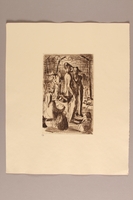
Albert Dov Sigal etching of 2 men at the detention camp fence created from a drawing done during his imprisonment
Object
Artist's proof for an etching based on a drawing created by Albert Dov Sigal in 1948 while he was imprisoned with his wife, Rozi, and young son, Daniel, in a British detention camp in Cyprus waiting for permission to enter Palestine. The print depicts 2 men conversing next to a seated woman with a woman and infant standing in the background near the barbed wire fence. Palestine was ruled by the British under a United Nations mandate and the postwar immigration policy was very restrictive. Ships attempting to bring unauthorized refugees to the country were stopped and the passengers were interned. In 1939, Sigal was arrested by the fascist, antisemitic Romanian government and assigned to a forced labor battalion that repaired and built roads and railways. He started an underground art school with a group of friends and was active in the Romanian resistance. On December 27, 1947, the family sailed from Burgas, Bulgaria, towards Palestine aboard the Aliyah Bet illegal immigrant ship, Pan York. They were imprisoned by the British on Cyprus on December 31, 1947. Because his son was only 18 months old, Sigal and his family were permitted to enter Palestine on February 22, 1948. On May 14, the state of Israel was established and, within six months, all the refugees on Cyprus were welcomed into the Jewish homeland.
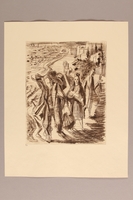
Albert Dov Sigal monochrome sepia etching of a young woman, holding an infant, with her family near the seaside based upon his experience as a refugee
Object
Artist's proof for an etching based on a drawing created by Albert Dov Sigal based upon the experiences of his family as newly arrived emigrants to Palestine on February 22, 1948. It depicts the artist and his family as they arrive in their new home. It is an image of a man carrying bags being followed by two woman: one holds an infant, the other carries a sack, as they walk along a seaside road with a small village in the background. See 1990.242.2 and 1992.113.14 for other versions of this scene. Palestine was ruled by the British under a United Nations mandate and the postwar immigration policy was very restrictive. Ships attempting to bring unauthorized refugees to the country were stopped and the passengers were interned. In 1939, Sigal was arrested by the fascist, antisemitic Romanian government and assigned to a forced labor battalion that repaired and built roads and railways. He started an underground art school with a group of friends and was active in the Romanian resistance. On December 27, 1947, the family sailed from Burgas, Bulgaria, towards Palestine aboard the Aliyah Bet illegal immigrant ship, Pan York. They were imprisoned by the British on Cyprus on December 31, 1947. Because his son, Daniel, was only 18 months old, Sigal, his wife, Rozi, and his mother were permitted to enter Palestine on February 22, 1948. On May 14, the state of Israel was established and, within six months, all the refugees on Cyprus were welcomed into the Jewish homeland.
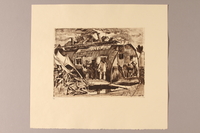
Albert Dov Sigal monochrome sepia etching of men near a metal hut in a detention camp created from a drawing done during his imprisonment
Object
Artist's proof of an etching based on a drawing created by Albert Dov Sigal in 1948 while he was imprisoned with his wife, Rozi, and young son, Daniel, in a British detention camp in Cyprus waiting for permission to enter Palestine. The print depicts men gathered near metal Nissen hut, possibly a bathing facility, with plants and other structures nearby. Palestine was ruled by the British under a United Nations mandate and the postwar immigration policy was very restrictive. Ships attempting to bring unauthorized refugees to the country were stopped and the passengers were interned. In 1939, Sigal was arrested by the fascist, antisemitic Romanian government and assigned to a forced labor battalion that repaired and built roads and railways. He started an underground art school with a group of friends and was active in the Romanian resistance. On December 27, 1947, the family sailed from Burgas, Bulgaria, towards Palestine aboard the Aliyah Bet illegal immigrant ship, Pan York. They were imprisoned by the British on Cyprus on December 31, 1947. Because his son was only 18 months old, Sigal and his family were permitted to enter Palestine on February 22, 1948. On May 14, the state of Israel was established and, within six months, all the refugees on Cyprus were welcomed into the Jewish homeland.

